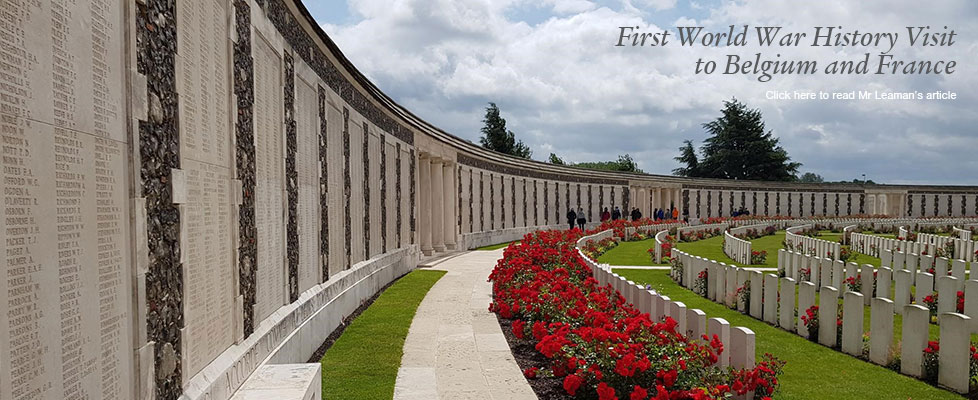On Thursday 6th June, 40 of our wonderful Year 9 students embarked on a tour of Belgium and Northern France to further their understanding of the First World War. In just 3 short days they explored various sites across Belgium and Northern France which helped to tell the story of a war that began over 100 years ago, which resulted in the deaths of up to 20 million people, and set the scene for a century of conflict and tension.

Day one:
We left school at 5am and journeyed towards Dover. By 10am we were on the Ferry to Calais. We then drove up into Belgium to our first stop, Sanctuary Wood. This site is now one of the few places on the Ypres Salient battlefields where an original trench layout can be seen in some semblance of what it might have looked like. Elsewhere the trenches were filled in and ploughed over by returning farmers. There were numerous battlefield relics and artefacts to be seen on the site, which were found by the owner of the farm after the conflict.

After this visit, we stopped at the hotel for dinner, then walked into the centre of Ypres for some free time. During the First World War, Ypres (or “Wipers” as it was commonly known by the British troops) was the centre of the Battles of Ypres between German and Allied forces.
Day Two:
We began our second day with an early breakfast before we travelled back into France. Our first stop was Lochnagar crater. It is the largest man-made mine crater created in the First World War on the Western Front. The mine was exploded at 7.28am signalling the launch of the British offensive against the German lines, and the start of the battle of the Somme, on the morning of 1st July 1916. The explosion was so large it created a crater 30 m deep and 100m wide. Our students were able to walk around the crater and get a sense of how the very flat terrain of Belgium created problems for both sides during the First World War.
After this we visited Thiepval. The Thiepval Memorial to the Missing of the Somme is a war memorial to over 72,000 missing British and South African servicemen who died in the Battles of the Somme of the First World War between 1915 and 1918, with no known grave.
We also visited Vimy Ridge. The Canadian National Vimy Memorial is a war memorial site in France dedicated to the memory of Canadian Expeditionary Force members killed during the First World War. The First World War profoundly impacted the young nation of Canada. From a population of under 8 million, some 619,000 Canadians enlisted in the Canadian Expeditionary Force for service. Sadly, more than 66,000 did not return home and another 172,000 were wounded.
After dinner at restaurant in Ypres, we watched the Last Post Ceremony at the Menin Gate. The short ceremony, in remembrance of those who fought and died in WW1, has happened almost every day at the Menin Gate since 1928.
As part of the ceremony a few lines are read from Laurence Binyon’s poem “For the Fallen”:
“They shall grow not old, as we that are left grow old:
Age shall not weary them, nor the years condemn.
At the going down of the sun and in the morning,
We will remember them.”

Day Three:
On our final day we conducted several visits to sites including Hill 60/Caterpillar Crater, the scene of intense fighting during December 1914 through into 1915. The location was important because it was higher ground in an otherwise flat landscape, therefore it obviously had great strategic importance to both the Germans and the Allies.
Next on our list was Langemark German Cemetery. The nickname “Studentenfriedhof” (Student Cemetery) was given to the cemetery because of the large number of university students among these German army volunteers. More than 44,000 soldiers are buried here. The site helped us to illustrate the differences between British and German traditions.

We also went to Tyne Cot and the Passchendaele museum. Tyne Cot is the largest Commonwealth War Graves Commission cemetery in the world. It is now the resting place of more than 11,900 servicemen of the British Empire from the First World War. Many of those who fell in the battle of Passchendaele 1917 are buried here.


After this we made our long journey back towards Calais, then Dover, and eventually Bath by midnight.
All of our students were fantastic for the duration of the trip. Thank you to all those who came along, we hope you enjoyed the experience. We hope to run the same experience for year 9 students next year.
Mr Leaman
Teacher of History








